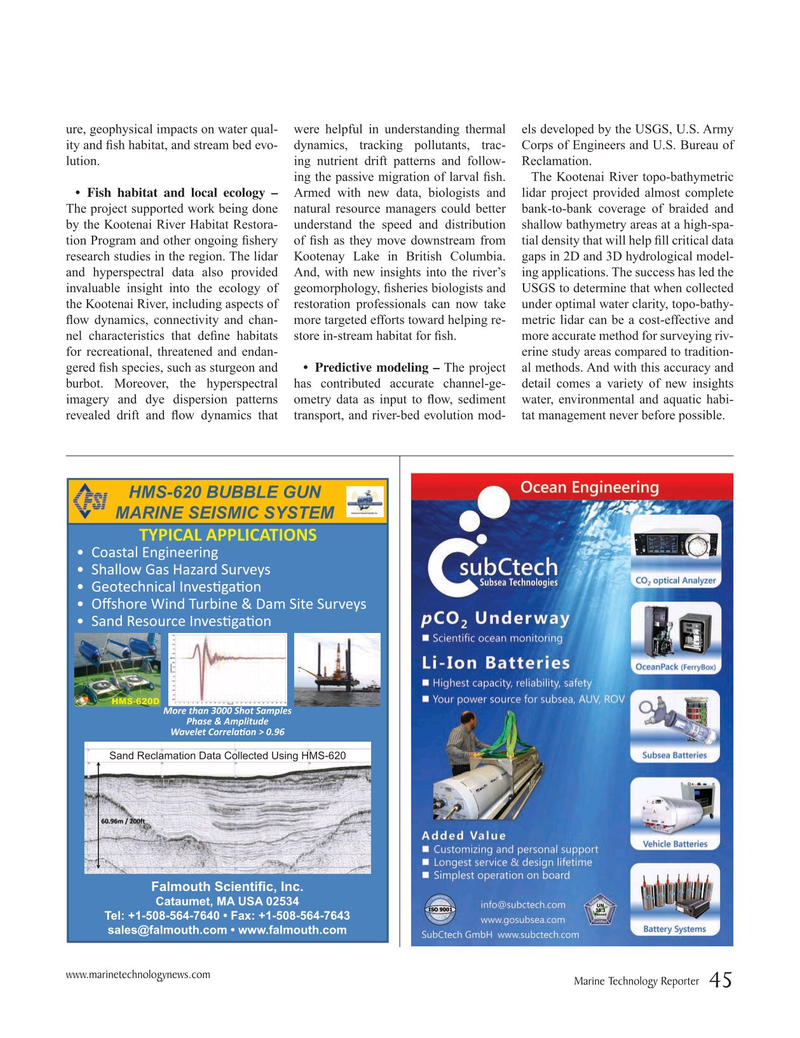
Page 45: of Marine Technology Magazine (November 2019)
MTR White Papers: Subsea Vehicles
Read this page in Pdf, Flash or Html5 edition of November 2019 Marine Technology Magazine
ure, geophysical impacts on water qual- were helpful in understanding thermal els developed by the USGS, U.S. Army ity and ? sh habitat, and stream bed evo- dynamics, tracking pollutants, trac- Corps of Engineers and U.S. Bureau of lution. ing nutrient drift patterns and follow- Reclamation.
ing the passive migration of larval ? sh. The Kootenai River topo-bathymetric • Fish habitat and local ecology – Armed with new data, biologists and lidar project provided almost complete
The project supported work being done natural resource managers could better bank-to-bank coverage of braided and by the Kootenai River Habitat Restora- understand the speed and distribution shallow bathymetry areas at a high-spa- tion Program and other ongoing ? shery of ? sh as they move downstream from tial density that will help ? ll critical data research studies in the region. The lidar Kootenay Lake in British Columbia. gaps in 2D and 3D hydrological model- and hyperspectral data also provided And, with new insights into the river’s ing applications. The success has led the invaluable insight into the ecology of geomorphology, ? sheries biologists and USGS to determine that when collected the Kootenai River, including aspects of restoration professionals can now take under optimal water clarity, topo-bathy- ? ow dynamics, connectivity and chan- more targeted efforts toward helping re- metric lidar can be a cost-effective and nel characteristics that de? ne habitats store in-stream habitat for ? sh. more accurate method for surveying riv- for recreational, threatened and endan- erine study areas compared to tradition- gered ? sh species, such as sturgeon and • Predictive modeling – The project al methods. And with this accuracy and burbot. Moreover, the hyperspectral has contributed accurate channel-ge- detail comes a variety of new insights imagery and dye dispersion patterns ometry data as input to ? ow, sediment water, environmental and aquatic habi- revealed drift and ? ow dynamics that transport, and river-bed evolution mod- tat management never before possible.
HMS-620 BUBBLE GUN
MARINE SEISMIC SYSTEM
TYPICAL APPLICATIONS • Coastal Engineering • Shallow Gas Hazard Surveys • Geotechnical InvesO gaO on • Oi shore Wind Turbine & Dam Site Surveys • Sand Resource InvesO gaO on
HMS-620D
More than 3000 Shot Samples
Phase & Amplitude
Wavelet CorrelaO on > 0.96
Sand Reclamation Data Collected Using HMS-620
Falmouth Scienti¿ c, Inc.
Cataumet, MA USA 02534
Tel: +1-508-564-7640 • Fax: +1-508-564-7643 [email protected] • www.falmouth.com www.marinetechnologynews.com
Marine Technology Reporter 45
MTR #9 (34-49).indd 45 12/5/2019 3:21:41 PM

 44
44

 46
46
